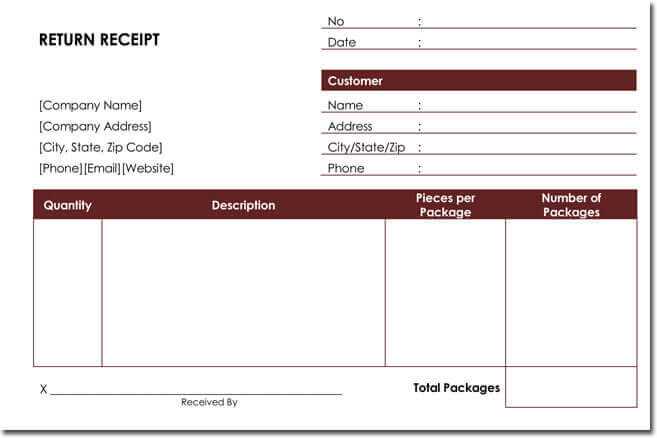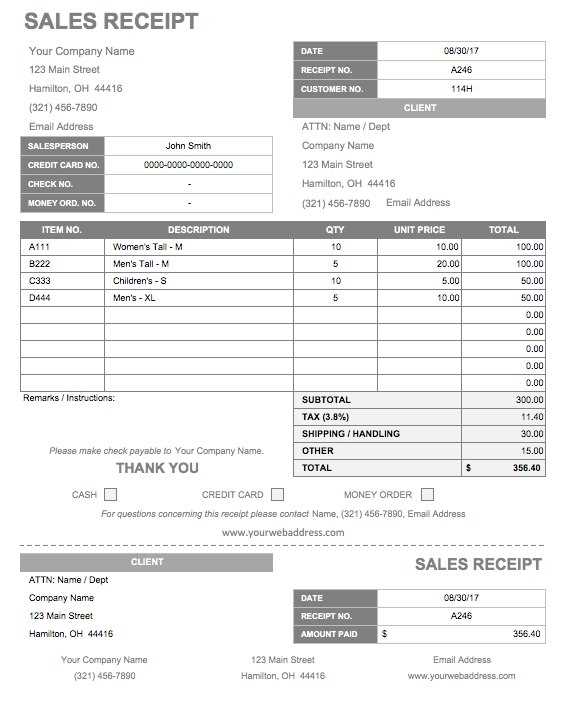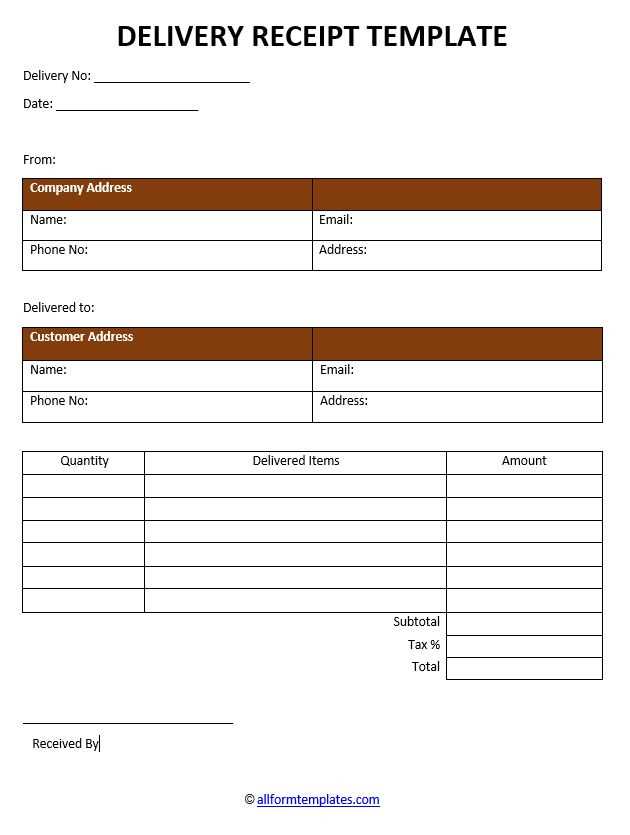
Make sure your receipt includes clear details for the return process. Include the date of the original purchase, the item description, and the reason for the return. This provides transparency for both you and the customer.
List of Required Information: The template should specify the transaction ID, purchase price, and any applicable taxes. You’ll also want to add the store’s return policy for easy reference. Clear, concise language helps avoid confusion later.
Ensure Accuracy: Always double-check the item condition and the return reason. These elements may impact any refund or exchange, and clarity here benefits both parties.
- Receipt Template for Item Return
A clear return receipt streamlines the process for both the customer and the store. It should provide all necessary details to track the return and resolve any potential disputes. Below is a receipt template that ensures you cover the key elements required for an effective return documentation:
| Field | Description |
|---|---|
| Store Name | Provide the name of the store where the item was purchased and returned. |
| Return Date | List the date when the return transaction occurred. |
| Customer’s Name | Include the full name of the person returning the item. |
| Item Description | Provide a brief description of the item being returned, including model number and condition. |
| Reason for Return | Specify the reason for the return (e.g., damaged, wrong item, or customer satisfaction). |
| Original Purchase Information | Include the original purchase date and receipt or transaction number for reference. |
| Refund Amount | State the amount refunded to the customer (if applicable), or note store credit details. |
| Authorized Signature | Provide space for a store representative’s signature to confirm the transaction. |
This template covers all critical details needed for item return receipts. It ensures transparency and smooth processing for both the store and the customer. Keep this format simple and consistent to avoid confusion and maintain a professional approach to returns.
A well-structured return receipt ensures clarity and smooth processing for both the customer and the retailer. Here’s a breakdown of the key details to include:
- Return Date: Clearly state the date when the item was returned. This serves as a reference for processing and tracking.
- Item Description: Include the exact name, model, and any specific identifiers (like serial numbers) of the returned product.
- Reason for Return: Specify whether the item was returned due to defect, dissatisfaction, or any other valid reason. This helps clarify the return context.
- Original Purchase Date: Mention the date the item was initially purchased. This is important for warranty or return window validations.
- Transaction or Order Number: Add the unique reference number associated with the purchase. This allows easy linking to the original sale.
- Refund or Exchange Method: Indicate whether the customer received a refund or if the item was exchanged. This is crucial for tracking the return’s outcome.
- Customer Details: Include the customer’s name and contact information. It ensures the return is correctly associated with the right individual.
- Signature or Confirmation: A signature or electronic confirmation from the customer can help validate the return, ensuring both parties agree to the terms.
Including these details guarantees a smooth process and can resolve any potential disputes quickly. Keep the information clear, concise, and accurate to avoid confusion.
Clearly structure the receipt with sections that are easy to identify. Start with the title at the top, stating “Return Receipt” or “Item Return Confirmation” to avoid any confusion. List the store name and contact information prominently, followed by the date of the return. This will help anyone looking at the receipt quickly locate the source and the timing of the return.
Item Information
Next, provide clear details about the returned item, including the product name, model number (if applicable), quantity, and price. This helps avoid ambiguity in case of questions about the specific product. Be sure to include any serial numbers or identifying codes to ensure the exact item is recorded.
Return Reason and Condition
Describe the reason for the return, whether it’s due to defect, dissatisfaction, or other reasons. If applicable, note the condition of the item at the time of return (e.g., unused, opened but in original condition). This transparency helps the store process the return accurately and provides context for any future queries.
Finally, show the return method clearly–whether it’s a refund, exchange, or store credit. Provide the amount returned or credited, and include transaction numbers or reference IDs if available. This ensures that both parties can verify the return process and avoid any misunderstandings later on.
Return receipts should clearly indicate both the terms of return and the customer’s rights. The receipt serves as legal proof of the return transaction, which can be crucial in resolving any disputes that may arise.
- Proof of Return: The receipt must confirm that the item has been returned and provide details of the transaction, including item description, return date, and return method (e.g., in-store, by mail).
- Return Policy Compliance: Ensure that the return complies with the retailer’s or manufacturer’s return policy. This includes return time frames, condition requirements (e.g., unused, original packaging), and applicable restocking fees.
- Refund Rights: The receipt should outline whether a refund is provided or if an exchange or store credit is offered instead. It may also specify how the refund will be processed (e.g., to the original payment method or as a credit).
- Warranty Considerations: If the return is linked to a warranty issue, the receipt should reference any warranty terms and conditions that apply. This helps clarify the customer’s rights regarding repairs, replacements, or refunds under warranty.
- Consumer Protection Laws: Retailers must comply with local and national consumer protection laws. These laws often mandate that returns be processed within a specified time frame and under specific conditions. The receipt should reflect these legal requirements.
When customizing a return receipt, adjust the details based on the product type to ensure clarity and accuracy for both the buyer and the seller.
For Electronics
Include serial numbers, model details, and warranty information. Specify whether the return is due to a malfunction, user preference, or damage during shipping. Clear details about the condition of the product are crucial to avoid misunderstandings.
For Clothing and Apparel

Note the size, color, and any specific features of the item. If the return is due to fit or style, this should be indicated clearly. Additionally, mention whether the item is in its original packaging, as this can impact the return policy.
For perishable goods, note expiration dates or any specific conditions that could influence the return. Always state whether the product has been opened or used to prevent disputes over product condition.
Organize returns in a centralized database, ensuring every return request is logged with key details like customer name, product description, date of purchase, and reason for return. This allows quick access to return histories and simplifies managing multiple transactions simultaneously.
Utilize Barcode Scanning for Returns
Implement barcode scanning at the point of return to reduce errors. By scanning product barcodes, you can instantly track returned items, associate them with customer data, and update inventory levels automatically. This minimizes manual entry and increases accuracy.
Set Return Deadlines and Policies

Clearly define return deadlines and policies in your system to avoid confusion. Automating alerts when returns approach the deadline ensures timely processing and can help prevent abuse of return privileges. Link returns with specific policies to make decision-making seamless.
| Return ID | Product Name | Customer Name | Return Date | Status |
|---|---|---|---|---|
| 001 | Wireless Mouse | John Doe | 2025-02-01 | Processed |
| 002 | Smartphone | Jane Smith | 2025-02-02 | Pending |
| 003 | Bluetooth Headphones | Mark Johnson | 2025-02-03 | Approved |
Establishing clear policies and automating tracking will streamline your return process. With the right tools and approach, handling returns can be done with precision and efficiency, reducing overhead and improving customer satisfaction.
Start by keeping a clear and detailed return receipt. It serves as proof that the item was returned, including the date, item description, and condition. A well-documented receipt helps clarify any misunderstandings with retailers or service providers.
Next, cross-check the return policy to ensure that your return meets all conditions outlined by the store. If there’s a dispute, you can show the policy alongside the return receipt to demonstrate compliance with the agreed terms.
- Keep a copy of the receipt, along with any communication with the retailer, in case further action is needed.
- Use the receipt to confirm whether the return was processed correctly–if not, it will support your claim.
- If there’s a refund issue, use the receipt to track the refund process and the amount that should have been returned.
If you reach out to customer support, refer to the return receipt and detail the discrepancy. Provide copies of all relevant information, and request clarification or action. It shows you have all the necessary documentation to back up your claim.
Lastly, if resolution isn’t reached directly with the company, escalate the matter to consumer protection services, presenting the return receipt as proof of the transaction. This can significantly strengthen your case in a dispute.
To create a receipt template for an item return, focus on providing clear and precise information. List the return date, item description, and reason for the return. Include transaction details such as order number and original purchase date for verification. Provide a section for the customer to sign and acknowledge the return. Ensure the format is easy to read and understand, with all necessary fields included for both parties’ records.
Key Sections to Include
Start with the customer’s name and contact details for identification. Add a brief description of the returned item, including the quantity, SKU or serial number, and condition. Include a clear reference to the original purchase, such as the order number, invoice, and purchase date. Specify the refund method, whether it is through credit, exchange, or cash. Ensure there’s a section for store or employee details to confirm receipt of the return.
Additional Considerations

Use a clean, simple layout that can be easily customized for different return scenarios. Keep the language straightforward to avoid confusion. If applicable, provide any terms and conditions related to returns at the bottom, including the return window and any restocking fees. Provide a space for notes or comments to include any special instructions for processing the return.


